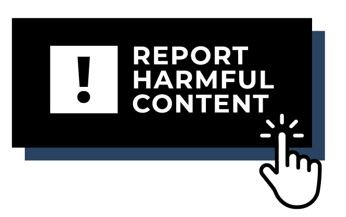The internet is a vast ocean of information and content. While many of us will go online and have a positive experience, we must accept that this is not always the case. Unfortunately, with every piece of insightful content we see, there are times when we can come across something hurtful, damaging or upsetting. The freedom that many of us can experience online can pave the way for many things but it shouldn’t come at the expense of harming others. So when we see something online that we know is harmful, it is time to take action and report it.
 A lot of us can fall victim to online harm, being targeted with abuse, threats, harassment and unwanted sexual advances amongst many other things. Being targeted by a perpetrator of online harm can make us feel powerless, alone and without support. Despite this, reporting allows us to take back some control whilst getting support from those who can help!
A lot of us can fall victim to online harm, being targeted with abuse, threats, harassment and unwanted sexual advances amongst many other things. Being targeted by a perpetrator of online harm can make us feel powerless, alone and without support. Despite this, reporting allows us to take back some control whilst getting support from those who can help!
Even if we aren’t being targeted ourselves, we’ve all seen something online that we know is hurting someone, somewhere. Rather than ignore it, reporting it is a small step towards showing perpetrators that this type of harmful behaviour will not be tolerated online.
When Should I Report?
If you see something online that you know is harmful or makes you feel uncomfortable, reporting it is always the best option. When you make a report, you are essentially escalating it for review. This process essentially determines whether something should remain online or not with reference to the law or specific standards and guidelines associated with online platforms. You should always report if you come across content that:

Contains child sexual abuse material or terrorist content

Is harmful or abusive towards yourself or others

Promotes self-harm or suicide

Contains violent content

Impersonates you or others

Contains pornographic content

Contains unwanted sexual advances

Threatens you or others
Who Should I Report To?
Different services may be required for different types of content, for example Report Harmful Content provides advice for everyone on how to report harm online. There are different reporting routes for different types of harm and the website provides advice on how to report both illegal and legal but harmful content. To get a better understanding of where you should go to for support, follow the below guide.

Police - 999
If you or the person you are helping is in immediate danger
Reporting at School
Developing a school community approach towards reporting can help build confidence around students navigating the internet with a clear understanding of what to do when they come across something upsetting online. Services such as Report Harmful Content are available to anyone over the age of 13 but just encouraging young people to tell a trusted adult when they encounter harmful online content is an important first step to getting something reported.
around students navigating the internet with a clear understanding of what to do when they come across something upsetting online. Services such as Report Harmful Content are available to anyone over the age of 13 but just encouraging young people to tell a trusted adult when they encounter harmful online content is an important first step to getting something reported.
If your school wants to encourage reporting within the community, the Report Harmful Content Button can be placed on your school website which will signpost students over 13 towards support. As well, the anonymous communication tool Whisper can help students come forward to report issues and concerns they may be having, in a safe way that also protects their privacy.
Reporting Resources & Guidance
Other Services and Support
As well as the above, there are other services available to support you or someone else experiencing a particular issue or concern. Take a look at the below to see if they can help, and to see the advice and support they can provide:
If you need support to report an issue please visit any of the links included on this page, or you can find out more about our Helplines to see how they can help. Discover more about any of the services from this page by signing up to our newsletter or by following us on Twitter, Facebook, LinkedIn and Instagram.
Improve Understanding
To further support the young people you work with about the issues covered on this page, teachers and professionals can access ProjectEVOLVE EDU, our online safety training platform. Learn more about the platform and the support it provides or subscribe to the full version.





















